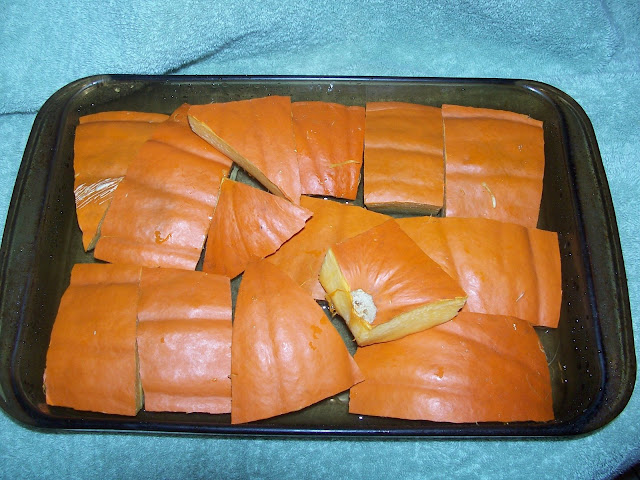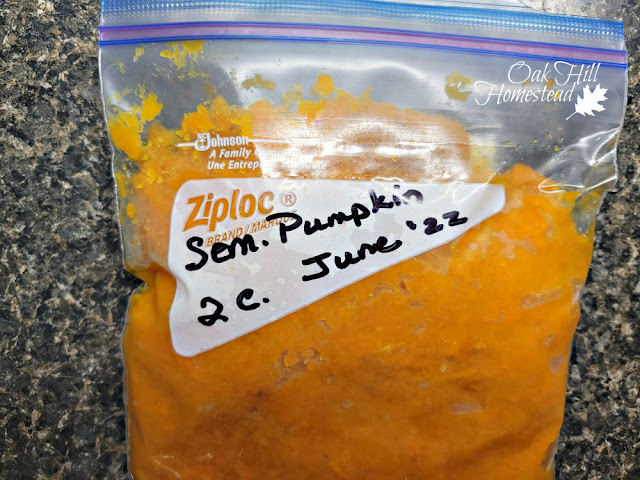Pumpkins are popular as fall decorations, but as soon as November arrives they are nearly worthless. Here's how to make pumpkin puree from fresh pumpkins.
How to make pumpkin puree from scratch
Have you noticed that pumpkins are suddenly worthless on November first?
All through the month of October there are pumpkins everywhere, in store displays, on your neighbor's front porch, and for sale at roadside stands.
I don't pay full price for pumpkins in October, but as soon as the calendar changes to November I can pick them up very cheaply and sometimes even for free.
This post may contain affiliate links. If you click a link and make a qualifying purchase, I might earn a small commission, but it won't affect the price you pay. You can read my full disclosure here.
I don't turn them into Jack-O-Lanterns. Instead, I process them into pumpkin puree, roast the seeds, and give the rest - the pumpkin shells, strings, etc. - to my chickens. They love pecking and eating pumpkin shells.
Where to find cheap or even free pumpkins
The big box store in town always discounts their pumpkins in November and I try to pick up a couple of those at half price or less. One year they were on sale for fifty cents each near the middle of the month, so I bought a couple more.
I heard that eventually they gave the remaining pumpkins away for free, but I wasn't in town that day. It was said that they were "pretty far gone," but they'd still have made some good, free chicken feed, or could have been added to a compost pile.
I've even scored a few free pumpkins for the asking at businesses that decorate with straw bales and pumpkins. It never hurts to ask.
If you live in a colder climate than I do, this might not work for you. Once they've frozen, they're only good for chicken feed.
But check them out anyway - if the pumpkin display was in a sheltered spot, they might have survived the cold temperatures, and if you have chickens, they'll love this free food.
Most of the pumpkins I bring home are usually still in very good shape. I turn them into pumpkin puree that goes in the freezer and eventually becomes pumpkin pie and other goodies.
The ones that are past the point of human consumption go to the chickens. My hens enjoy pecking at the flesh until all that's left is the hard, thin shell.
If you don't have chickens, break the pumpkins up and bury them in your compost pile.
Cut open the pumpkin
To process a pumpkin, start by cutting off the top and removing the seeds as though you're carving a Jack-o-Lantern.
Cut the pumpkin in half to make removing the strings easier. Be careful, the knife sometimes wants to slip off the round pumpkin, and that could be dangerous!
It's easier (and safer) to cut the pumpkin in half by starting at the hole where you've already cut the top off, then removing the seeds and strings.
The innards - the "top hat" of the pumpkin, the seeds and as many of the strings as you can scrape off the inside flesh of the pumpkin (I use a serrated grapefruit spoon) - make great chicken feed, as I said.
Roast pumpkin seeds
Or you can roast pumpkin seeds for a delicious snack. My husband loves them.
Wash the seeds, then lay them in a single layer on a kitchen towel and let them dry overnight.
When you're ready to roast them, toss the pumpkin seeds with a bit of cooking oil (and salt, if you wish).
Spread them out in a single layer on baking sheets, preheat your oven to 250°F and put the baking sheets in the oven for 10-15 minutes.
Remove from the oven and let the pumpkin seeds cool before eating.
 |
| Some of the seeds in this pumpkin had already begun to sprout! |
Sometimes I'll cut into a pumpkin and find that the seeds have already sprouted inside.
This is a normal process, and is how a pumpkin reproduces by seed. Sometimes the seeds just jump the gun a bit. It's called "vivipary."
My chickens loved the sprouted seeds, and I realized that pumpkin seeds could be sprouted (you know, on purpose!) and fed to the chickens as "green feed." Lightbulb moment!
How to cook fresh pumpkin
Cut the rest of the pumpkin into pieces and arrange in a roasting pan with a little water. Put the pumpkin pieces in the pan shell-side-up so the water helps to steam the pumpkin "meat."
You can't use a baking sheet for this. Please use a dish with sides to the water won't spill and make a mess.
Roast the pieces in a 325°F oven until the pumpkin meat is really soft when you poke it with a fork. Really soft, like warm butter. It can take awhile, but your patience will be rewarded.
Remove the roasting pan from the oven and set aside until the pumpkin is cool, then just peel the rind off.
Seriously, it's that easy! You don't have to scrape the pumpkin meat off the rind if you let it bake/roast until it's super soft.
Depending on the size of your pumpkin, you may need a couple of roasting pans, or need to do this in several shifts.

Turn roasted pumpkin into pumpkin puree
After removing the rind, mash the soft pumpkin meat with a fork OR you can break the pumpkin meat into chunks and puree in the food processor.
Since these probably aren't pie pumpkins, your pumpkin puree will usually have more water than commercially-canned pumpkin puree.
That's ok. You can put the pumpkin in a strainer and let the extra liquid drain off.
Canning pumpkin puree
Pumpkin puree is too dense to can safely at home, even in a pressure cooker. However, it can be canned in chunks if you prefer.
You can find directions to pressure-can pumpkin chunks here.
Can you freeze pumpkin puree?
Yes, you can freeze pumpkin puree! Since we're not supposed to can pumpkin puree, I always freeze mine.
Mash it well, and pack it into zip-top freezer bags or other freezer containers. Check your favorite recipes for the amounts you use the most, and package the puree for the freezer in those quantities.
I package mine in several sizes according to use:
- 3 3/4 cups of homemade pumpkin puree equals a large (29 oz) can of pumpkin puree for pie-making. (Note: not a can of "pumpkin pie mix.")
- Two cups can be substituted for a small can (15 oz) of pumpkin puree. This is the amount I use to make pumpkin bread.
- I package several one-cup portions too for other uses.
Label the bags or containers, and store them in the freezer.
If using zippered bags, lay them flat in a single layer on the freezer shelf to freeze. When well-frozen, you can stack the bags of frozen pumpkin puree in your freezer to save space.
While pumpkin puree lasts pretty much indefinitely in the freezer, the quality is best if used within 3 months.
Things to make with pumpkin puree
For my favorite pumpkin pie recipe - and tips on how you can make pumpkin pie without evaporated milk (because I always seem to be out of evaporated milk when I make a pumpkin pie, how about you?) - check out this post: How to Make Pumpkin Pie without Evaporated Milk
My mother's pumpkin bread recipe makes the best pumpkin bread you will ever taste. You simply must try this moist, richly-spiced recipe.
Many dog owners feed pumpkin puree to their dogs. High in natural fiber, pumpkin can help a dog maintain a healthy weight. You'll can read more about the benefits of pumpkin puree for dogs here.
For more simple-living and self-reliant posts like this, subscribe to my weekly-ish newsletter The Acorn, and join me on Facebook, Instagram and Pinterest.
How to Freeze Acorn Squash
Make Simmering Potpourri to Make Your House Smell Amazing
Easy, No-Knead Cottage Cheese Bread
~~~~~
Facebook | Pinterest | Subscribe | Instagram

















